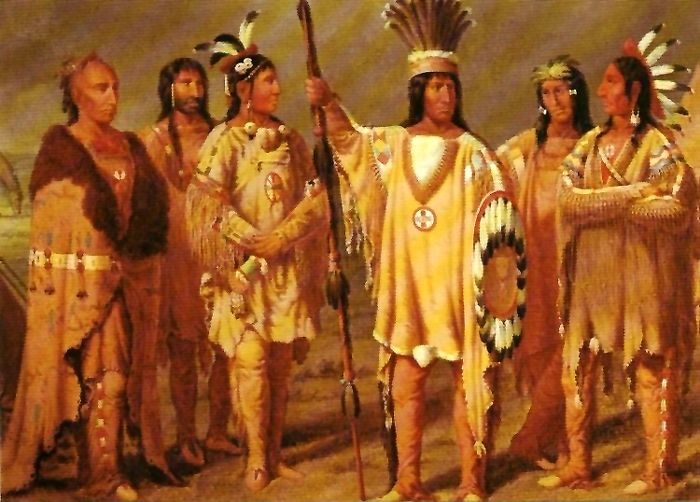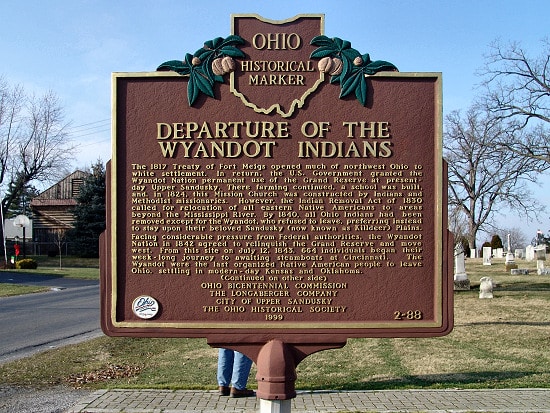The Wyandot Indian tribe, also known as the Huron Tribe, was located in present-day Ontario and Ohio.

Originally known as the Huron Indians, their name changed over time to the Wyandot, which is how they are recognized today.
The Wyandot were the last Native American tribe to leave Ohio. They were on the losing end of every conflict they entered, which included the French and Indian War, American Revolution, and they even supported the Confederate South and were pro-slavery during the Civil War.
They were known as resourceful and excellent warriors who fought bravely in every battle.
European Contact
The earliest written accounts of the Huron were made by the French, who began exploring North America in the 16th century. News of the Europeans reached the Huron, particularly when Samuel de Champlain explored the Saint Lawrence River in the early 17th century. Some Huron decided to go and meet the Europeans. Atlanta, the principal headman of the Arendarhonon tribe, went to Quebec and allied with the French in 1609.
The Jesuit Relations of 1639 describes the Huron:
They are robust, and all are much taller than the French. Their only covering is a beaver skin, which they wear upon their shoulders in the form of a mantle; shoes, and leggings in winter. A tobacco pouch behind the back, a pipe in hand; around their necks and arms bead necklaces and bracelets of porcelain; they also suspend these from their ears and around their locks of hair. They grease their hair and faces; they also streak their faces with black and red paint.
Jesuit François du Peron, Jesuit Relations (1898) Volume XV
The total population of the Huron at the time of European contact has been estimated at 20,000 to 40,000 people. From 1634 to 1640, the Huron were devastated by Eurasian infectious diseases, such as measles and smallpox, which were endemic among the Europeans. The Indians of North America had no acquired immunity to these diseases and suffered very high mortality rates.
So many Huron died that they abandoned many of their villages and agricultural areas. About half to two-thirds of the population died in the epidemics, decreasing the population to about 12,000. Such losses had a high social cost, devastating families and clans and disrupting their society's structure and traditions.
Before the French arrived, the Huron had already conflicted with the Haudenosaunee Confederacy (Five Nations) to the south. Several thousand Huron lived as far south as present-day central West Virginia along the Kanawha River by the late 16th century, but they were driven out by the Haudenosaunee, who invaded from present-day New York in the 17th century to secure more hunting grounds for the beaver trade.
Once the European powers became involved in trading, the conflict among natives intensified significantly as they struggled to control the lucrative fur trade and satisfy European demand. The French allied with the Huron because they were the most advanced trading nation at the time. The Haudenosaunee tended to ally with the Dutch and later the English, who settled at Albany and in the Mohawk Valley of their New York territory.
The introduction of European weapons and the fur trade increased competition and the severity of inter-tribal warfare. While the Haudenosaunee could easily obtain guns in exchange for furs from Dutch traders in New York, the Wendat were required to profess Christianity to obtain a gun from French traders in Canada. Therefore, they were unprepared. On March 16, 1649, a Haudenosaunee war party of about 1000 entered Wendake and burned the Huron mission villages of St. Ignace and St. Louis in present-day Simcoe County, Ontario, killing about 300 people.
The Iroquois also killed many of the Jesuit missionaries, who have since been honored as North American Martyrs. The surviving Jesuits burned the mission after abandoning it to prevent its capture. The extensive Iroquois attack shocked and frightened the surviving Huron.
The Huron were geographically cut off from trade with the Dutch and British by the Iroquois Confederacy, who had access to free trade with all the Europeans in the area, especially the Dutch.
This forced them to continue to use lithic tools and weapons like clubs, arrows, stone scrapers, and cutters. This is compared to the near-universal use of European iron tools by Iroquois groups in the area. Huron trade routes were consistently pillaged by raiders, and the lack of firearms discouraged Huron's trade with the French, at least without French protection.
As a result of their lack of exposure, the Huron did not have as much experience using firearms compared to their neighbors, putting them at a significant disadvantage when firearms were available to them, and when available, their possession of firearms made them a larger target for Iroquois aggression.
By May 1, 1649, the Huron burned 15 of their villages to prevent their stores from being taken and fled as refugees to surrounding tribes. About 10,000 fled to Gahoendoe. Most who fled to the island starved over the winter, as it was an unproductive settlement and could not provide for them.
After spending the bitter winter of 1649–50 on the island, surviving Huron relocated near Quebec City, where they settled at Wendake. Absorbing other refugees, they became the Huron-Wendat Nation. Some Huron, along with the surviving Petun, whose villages the Iroquois attacked in the fall of 1649, fled to the upper Lake Michigan region, settling first at Green Bay, then at Michilimackinac.
Transition from Huron to Wyandot
In the late 17th century, elements of the Huron Confederacy and the Petun joined together and became known as the Wyandot (or Wyandotte), a variation of Wendat. (This name is also related to the French transliteration of the Mohawk term for tobacco.) The western Wyandot re-formed in the area of Ohio and southern Michigan in the United States.
In August 1782, the Wyandot joined forces with Simon Girty, a British soldier. On Aug 15 through 19, 1782, they unsuccessfully besieged Bryan Station in Kentucky (near present-day Lexington). They drew the Kentucky militia to Lower Blue Licks, where the Wyandot defeated the militia led by Daniel Boone. The Wyandot gained the high ground and surrounded Boone's forces.
Also, in late 1782, the Wyandot joined forces with Shawnee, Seneca, and Lenape Indians in an unsuccessful siege of Fort Henry on the Ohio River.
During the Northwest Indian War, the Wyandot fought alongside British allies against the United States. Under the leadership of Tarhe, they were signatories to the Treaty of Greenville in 1795.
In 1807, the Wyandot joined three other tribes – the Odawa, Potawatomi, and Ojibwe people – in signing the Treaty of Detroit, which resulted in a major land cession to the United States. This agreement between the tribes and the Michigan Territory (represented by William Hull) ceded to the United States a part of their territory in today's Southeastern Michigan and a section of Ohio near the Maumee River.
The tribes were allowed to keep small pockets of land in the territory. The Treaty of Brownstown was signed by Governor Hull on November 7, 1807, and provided the Indian Nations with a payment of $10,000 in goods and money along with an annual payment of $2,400 in exchange for an area of land that included the southeastern one-quarter of the lower peninsula of Michigan. In 1819, the Methodist Church established a mission to the Wyandot in Ohio, its first to Native Americans.
In the 1840s, most of the surviving Wyandot people were displaced to Kansas Indian Territory through the US federal policy of forced Indian removal. Using the funds they received for their lands in Ohio, the Wyandot purchased 23,000 acres of land for $46,080 in what is now Wyandotte County, Kansas, from the Lenape.

The Lenape had been grateful for the hospitality that the Wyandot had given them in Ohio, as the Lenape had been forced to move west under pressure from colonists. The Wyandot acquired a more-or-less square parcel north and west of the junction of the Kansas River and the Missouri River.
A United States government treaty granted the Wyandot Nation a small portion of fertile land located at an acute angle of the Missouri River and Kansas River, which they purchased from Delaware in 1843. Also, the government granted 32 "floating sections" located on public lands west of the Mississippi River.
In June 1853, Big Turtle, a Wyandot chief, wrote to the Ohio State Journal regarding the current condition of his tribe. The Wyandot had received nearly $127,000 for their lands in 1845. Big Turtle noted that, in the spring of 1850, the tribal chiefs retroceded the granted land to the government. They invested $100,000 of the proceeds in 5% government stock. After removal to Kansas, the Wyandot had founded good libraries along with two thriving Sabbath schools.
They were in the process of organizing a division of the Sons of Temperance and maintained a sizable temperance society. Big Turtle commented on the agricultural yield, which produced an annual surplus for the market. He said that the thrift of the Wyandot exceeded that of any tribe north of the Arkansas line. According to his account, the Wyandot nation was "contented and happy", and enjoyed better living conditions in the Indian Territory than they had in Ohio.
The Civil War
By 1855, the number of Wyandot had diminished to 600 or 700 people. On August 14 of that year, the Wyandot Nation elected a chief. The Kansas correspondent of the Missouri Republican reported that the judges of the election were three elders who were trusted by their peers.
The Wyandot offered some of the floating sections of land for sale on the same day at $800. A section was composed of 640 acres. Altogether, 20,480 acres were sold for $25,600. They were located in Kansas, Nebraska, and unspecified sites. Surveys were not required, with the title becoming complete at the time of location.
The Wyandot played an important role in Kansas politics. On July 26, 1853, at a meeting at the Wyandot Council house in Kansas City, William Walker (Wyandot) was elected provisional governor of Nebraska Territory, which included Kansas. He was elected by Wyandot, white traders, and outside interests who wished to preempt the federal government's organization of the territory and to benefit from the settlement of Kansas by white settlers. Walker and
others promoted Kansas as the route for the proposed transcontinental railroad. Although the federal government did not recognize Walker's election, the political activity prompted the federal government to pass the Kansas–Nebraska Act to organize Kansas and Nebraska territories.
An October 1855 article in The New York Times reported that the Wyandot were free (that is, they had been accepted as US citizens) and without the restrictions placed on other tribes. Their leaders were unanimously pro-slavery, which meant 900 or 1,000 additional votes in opposition to the Free State movement of Kansas. In 1867, after the Civil War, additional members were removed from the Midwest to Indian Territory.
Where Are They Now?
The Wyandot have four bands with recognition in the U.S. and Canada: the Wyandotte Nation (Oklahoma); the Huron-Wendat Nation (First Nation in Canada); and the Wyandot Nations of Anderdon (Michigan) and Kansas, which are recognized at the state level.
In February of 1985, the U.S. government delivered $5 million dollars to descendants of the Wyandot people in partial compensation for the exploitative treaty of 1842.
Today, more than 4,000 Wyandot can be found in eastern Kansas and northeastern Oklahoma.
